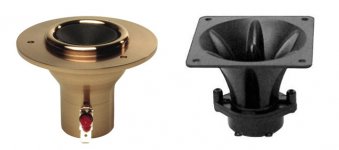I noticed this tweeter is sold at different prices. For example Solen sells it at $462 (each) while Madisound has it at $960 (pair) while another site, Noteworthy Audio lists it at only 170 GPB (about $271).
Madisound
Solen
Noteworthy Audio
Anyone have experience using this tweeter?
Madisound
Solen
Noteworthy Audio
Anyone have experience using this tweeter?
so much for nafta. any idea what customs, duty, taxes and poss. brokerage fees will do to that?
...we should have been nicer to scottmoose, to put together a group buy and handle the purchase and shipping :\
...we should have been nicer to scottmoose, to put together a group buy and handle the purchase and shipping :\
Ahh...yes I always forget about that, I guess that explains the higher price for the US dealers. As I'm new to this forum I'm lost concerning the rest of your post and the "group buy" reference. I didn't find much at all when I searched the forum for this tweeter. I did find one discussion on another forum where the general opinion was that this tweeter was good but "There are better ones available." Although I believe they were comparing to some ribbon tweeters which isn't particularly fair. I would be much more interested in comparing it to some of the Fostex tweeters for example (utilized as a supertweeter). I just think it's an interesting tweeter because it's construction is different from most others.
sorry about that, it was a joke that you wouldn't get without following many of the threads here. in short, scottmoose is from the UK and designed or had a hand in many of the enclosures made available to the diy community.
I've held a pair of those in my hand. A really nice piece of maching, but kind of hard to swallow that kind of dosh for a naked piezo tweeter.
dave
dave
I wonder how it compares sonically to the lemon squeezer peizo we all have seen... or any other for that matter... using a resistor and 1.5uf cap or higher?
Godzilla
Godzilla
You could pull the active element out of a lemon squeezer and remount it and get really close.
dave
dave
Smooooooth
I own a pair of Ocellia Tilias, and they employ this tweeter. The onus against the piezo tweeter is a testament to its' difficulty to employ. I have heard a successful design using the little ubiquitous (in the 80's) black tweeters you could make dance around the room by running them fullrange driven by a DYNA 400... but I digress.
The PHY driver appears to use a piezo electric motor to drive a paper cone, thereby combining the speed and power capacity, therefore the dynamic range, of a piezo with the tonal accuracy and smoothness of a paper cone.
I have driven these speakers with tubes and sand, single ended and push pull, low and high power amps, and the top end, which roll in at 11kHz, reminds me of an Acoustat 2+2. Very smooth and present, except with more body.
I hope this helps tour discussion.
I own a pair of Ocellia Tilias, and they employ this tweeter. The onus against the piezo tweeter is a testament to its' difficulty to employ. I have heard a successful design using the little ubiquitous (in the 80's) black tweeters you could make dance around the room by running them fullrange driven by a DYNA 400... but I digress.
The PHY driver appears to use a piezo electric motor to drive a paper cone, thereby combining the speed and power capacity, therefore the dynamic range, of a piezo with the tonal accuracy and smoothness of a paper cone.
I have driven these speakers with tubes and sand, single ended and push pull, low and high power amps, and the top end, which roll in at 11kHz, reminds me of an Acoustat 2+2. Very smooth and present, except with more body.
I hope this helps tour discussion.
Didn't the owner of PHY Bernard Salabert pass on? (RIP) I guess someone must have taken over and kept things going?.. Man, in the last handful of years we've sure been loosing a lot of great audio fellows, sad 🙁
Maybe it's me but i would like to examine and listen to these two products side by side. For the use intended (adding output to full range drivers above 10kHz or higher) I wonder how different they really are.
well if you have to ask, then you can't really afford the PHYs
I couldn't agree with Dave more on this one - I had occasion to build some OBs for the large PHY Coax and the very poorly optimized TQWP for the 8" driver a few years back - each was quite underwhelming or impractical in its own way
The PHY driver appears to use a piezo electric motor to drive a paper cone, thereby combining the speed and power capacity, therefore the dynamic range, of a piezo with the tonal accuracy and smoothness of a paper cone.
If you dissasemble a typical piezo tweeter that same paper cone is attached to the piezo motor... some radio shack speakers were the cone + motor mounted in a closed basket... they would be a more complete place to start to make a clone.
What you are paying for with these tweeters is the hand cast & machined brass support.
dave
- Status
- Not open for further replies.
- Home
- Loudspeakers
- Full Range
- PHY TW37 tweeter?
